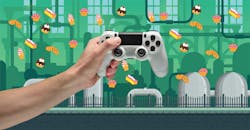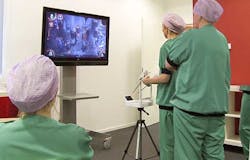Candy Crushing It: Gamifying Manufacturing to Train Millennials
Most manufacturers are now looking at a workforce that is 35% Millennials—the generation born between 1981 and 1996. According to Pew Research Center, Millennials became the largest generational group in the US labor force in 2016, when they overtook Gen Xers. In 2017, 56 million Millennials were working or looking for work.
And, since the Baby Boomers are retiring in droves, this number is only going to grow. Millennials are expected to be 75% of the workforce by 2025.
This younger workforce needs to be trained—they are graduating without many of the skills needed for manufacturing jobs—but the traditional talking head and paper manual training programs their parents sat through won't work with Generation Y.
A Generation of Gamers
Millennials and later generations were born into a digital world. (These days, by the time the average American has turned 21, they've spent 6,000 to 9,000 hours playing video games, but only about 2,000 hours reading books). They've been fed on video games, and it means they learn and play differently from older generations. Millennials are totally comfortable with technology, and research has shown that they crave variety in media and are born multitaskers, so they can't just sit and listen to a talking head, the way earlier generations used to.
Intuitively, it makes sense for training programs to use games, since Millennial brains are already working that way. The "gamification of training" means using game design techniques in a non-game situation to engage users and reinforce a specific skill or concept. Training games use techniques from the game world like rewards, points, badges, frequent feedback, progression through many levels, etc., to make training more effective by making learning more fun.
Does it work?
International pharmaceutical giant AstraZeneca explored using a voluntary, game-based learning system to get 500 sales agents up to speed about a new drug. Their objectives were to focus the agents on the new project, create an effective team building tool, create a buzz leading up to the launch of the drug, and to be able to check the training results in real time.
The game, called "Go to Jupiter," was custom designed by Italian gamification agency "alittleb.it". AstraZeneca wanted the game to be voluntary to maintain the sense of fun, so the developer built in lots of motivators like team competitions, cooperation within teams, mini-games with instant gameplay, virtual items, rewards for achievement, leaders boards and progressive levels.
The result? It worked. Usage rates were extremely high (97%), and 95% of the users completed each teaching session. Not only that, most of the agents were using the game outside of working hours. It proved to be an effective team-building tool that educated, focused, and energized the sales force.
In the UK, fast-food behemoth McDonald's began using gamification in 2011 to train front-line servers to use the new cash registers. The game led users through a 20-minute exercise of serving customers, becoming increasingly challenging as it progressed. They placed the game on the McDonald's portal, and within the first six weeks it was played by 50,000 people, saving the company £1/2 million in direct training costs.
There are many other examples of huge companies, such as SAP, Dell, Deloitte, and Google, using gamification not just for training but also to build community, engage workers, and motivate them to perform routine tasks.
The Breakdown: Serious versus Casual
In the gamification world, you're either serious or casual.
"Serious games" are games specifically designed for learning or practicing a particular skill, rather than for entertainment. They are mostly used in complex fields—for everything from industrial electrical troubleshooting to aeronautics, education, defense, and even surgery.
Take Grendel Games' "Underground." It's a serious game that helps surgical students practice the difficult skills involved in laparoscopic gallbladder surgery.
Although it falls into the serious category, it's actually fun to play. There's no sign of surgery at all, something tired students appreciate after a long day in the hospital. Instead, it presents a fantasy world of characters trapped underground that have to be rescued using physical movements that mimic the techniques used in laparoscopic surgery on a custom-designed Nintendo controller similar to the instruments used in the surgery. The game improves dexterity and creates muscle memory while the player is having fun.
Other examples of serious games are "Pulse!!", which trains emergency room nurses how to deal with admitting multiple patients, and Duolingo, the popular gamified language-learning software.
In contrast, casual games are purposely designed for entertainment. They are games with "very simple controls and low barriers to entry" that can be played for five minutes and then put aside (like Brainwell, Candy Crush, or Tetris).
A recent study of over 6,000 employees in the US and Canada found that being allowed to play a casual game for a few minutes before participating in training was a motivational hook that improved engagement. Trainees logged in to train significantly more often (so they were more likely to complete their training). Perhaps more surprising was that it put them in a mental zone where they could actually focus better, boosting their learning outcomes and improving recall.
Keeping Their Heads in the Game
Basically, it's all about engagement. Active learning approaches, where the student has to interact with the material being taught, are associated with greater academic achievement. This has been studied a lot in the medical world, where one study found that learners in an engaged classroom had better knowledge retention than non-engaged students. The same study found that high-fidelity simulation also improved students' knowledge retention.
Gamified training can also change habits, through repeated retrieval and spaced retrieval. Retrieval practice forces learners to recall information, rather than just listen to it or read it. On its own, retrieval practice can improve recall performance by 10% to 20%. Spaced retrieval is providing the learner with quizzes or course content spaced over time, and when combined with retrieval practice it multiplies the effect and improves recall performance by as much as 35% to 60%.
Gamification also generates intrinsic motivation in users through challenge, curiosity, competition, and other natural human motivators. For example, in jobs where output is easily measured, training games can use competitive features like company-wide leader boards to inspire either competition or teamwork.
Anything that boosts employee engagement is good for business—a 2012 Gallup study found that companies with an engaged workforce outperformed their non-engaged competition by 147%.
Hiring, Onboarding, and Retaining Staff
Certain training games can also be used by HR departments to test a job applicant's skills and aptitude. Just seeing how an applicant performs on the software can reveal a lot about how they will perform their job.Once the staff are hired, gamification is also effective for onboarding to help introduce the new employees to corporate culture and processes. Daniel Newman, CEO of Broadsuite Media Group and author of Futureproof: 7 Key Pillars for Digital Transformation Success, says:
"In terms of training, companies have the chance to move beyond required—often boring—webinars to more interactive training methods that reinforce policies and culture every single day. It can also help companies retain staff because it makes work more fun. Psychology is part of gamification, and a huge part of that is simply making day-to-day work life more enjoyable."
Dan R. Lawrence is Director of Marketing at Simutech Multimedia, which makes simulation-based, gamified troubleshooting training solutions driven by artificial intelligence.
About the Author
Dan R. Lawrence
Director of Marketing
Dan Lawrence is Director of Marketing at Simutech Multimedia. He is responsible for marketing, communications, and building awareness for Simutech Multimedia's simulation-based, gamified troubleshooting training solutions driven by artificial intelligence. His previous roles include leading and implementing strategic marketing programs to sustain and drive the growth of several leading startups and technology companies.

